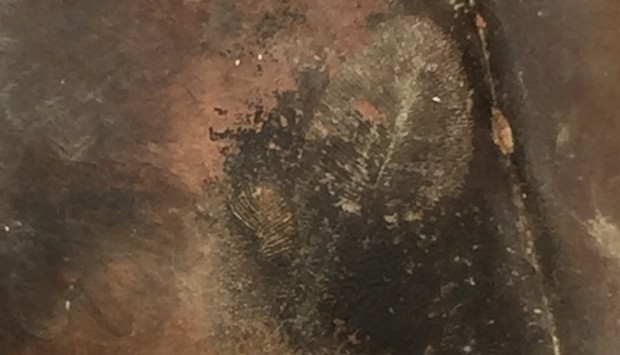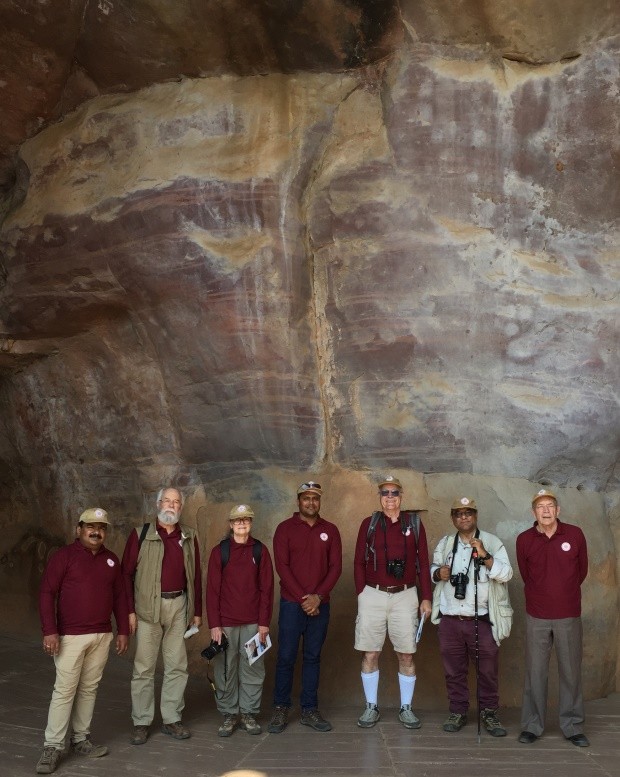
The fossil found nestled in the Bhimbhetka cave art. © Retallack, G. J. et al.
In March 2020, geologists making a sightseeing stop to the central Indian caves of Bhimbhetka were puzzled by an unusual leaf-like impression nestled within millennia-old cave art. They now report that the impressions were that of the fossil Dickinsonia, one of the earliest examples of complex multicellular life on earth, and the first such spotted in India1.
Ranjit Khangar and Merajuddin Khan of the Geological Survey of India led the trip to the captivating cave art collection in Madhya Pradesh when the team noticed, high up on the walls, a distinct centimetres-length form, symmetric around a midline. Unable to directly sample the protected wall, the geologists photographed these shapes and subjected them to a 3D analysis back in their lab.
They identified the impressions as the fossil Dickinsonia, a well-known member of the ‘Ediacaran biota’, a catch-all term that includes diverse fossils of early multicellular life. Among this biota are the first animal fossils from 600 million years ago. Elsewhere in Russia and Australia, Dickinsonia is found in rocks 555-550 million years old.
If the team’s findings are validated further with direct sampling of the fossil, or by finding more such impressions at other locations, it could settle a long-running debate about the age of the Vindhyan rocks of central India. The strata of the Vindhyan Basin, which takes its name from the Vindhya mountains, are surmised to be between 1600 to 541 million years old. The rocks at Bhimbetka form the uppermost strata of the Vindhyan Basin. The Bhimbetka sandstones were deposited in a coastal setting, comprising the intertidal zone and landward sand dunes. The finding thus provides insights into the ecologic range of emerging complex life.

The fossil found nestled in the Bhimbhetka cave art. © Retallack, G. J. et al.
Geologists use a technique known as the ‘youngest detrital zircon’, which indicates the age of the youngest eroding source rock, and hence provides the approximate age of sediment depositions. This technique used on the upper strata of the Vindhyan rocks had earlier hinted it to be 900 to 850 million years old. Later, fossil finds known as Arumberia, thought to be microbial filaments, suggested that the rocks were 600 to 550 million years old. In 2020, geologists reported 548 million-year-old zircons from the Maihar Sandstone2, of which the Bhimbetka rocks are a part. And now, this putative Dickinsonia adds a third line of evidence that the uppermost Vindhyan rocks were deposited during the geological time period called Ediacaran, between 637 and 541 million years ago.
Not everyone is convinced by this startling identification though. Paleontologist Emily Mitchell of the University of Cambridge suggested that it could be another painting. The study though points out that these impressions are stylistically very different from the surrounding paintings and etchings. Their morphologic analysis also shows a close similarity in form with well-documented Dickinsonia from Australia.
The biological affinity of Dickinsonia is controversial. Most scientists tend to accept it as an early animal. Some like Gregory Retallack, co-discoverer of this fossil, think of it to be a large algae or lichen. He argues that the mainstream view that Dickinsonia was a marine animal is based on weak evidence, while his own detailed work shows that Dickinsonia was a land creature, forming biogenic crusts on soils. Interestingly, the Bhimbetka rocks were deposited in a mostly terrestrial setting, more in alignment with Retallack's interpretation. Importantly for geology, its restricted time span, habing been found only in rocks between 555-550 million years old, makes it a diagnostic indicator of age. So far, no animal fossils have been found in the Vindhyan rocks. This finding may inspire geologists to start searching contemporaneous Indian basins afresh for such subtle clues.
Around 630 million years ago, the earth shook itself out of a brutally cold period, aptly named the Cryogenian, which had lasted the preceding 85 million years. In the ensuing Ediacaran period, changes in ocean chemistry, fluctuating oxygen levels and drifting continents provided fertile environment for biological innovation to take root. The Ediacaran biota, named after the Ediacaran Hills in Australia, is an early phase of complex multicellular life, which diversified greatly later in the Cambrian period. Global surveys have found the first sponges and cnidarians (a group that includes corals) in 600-560 million-year-old rocks. The earliest traces of mobile bilateral animals manifest as burrows and their tracks are traceable to around 560 million years ago. Dickinsonia has been tentatively identified as a bilaterian, meaning animals with bilateral symmetry.
During this time period, India, Australia and Antarctica were parts of the nascent supercontinent Gondwana, as borne by latitude-dependent magnetic patterns frozen in igneous rocks at the time of their formation. Analysis of the fossil hosting sedimentary rocks points to a coastal, semi-arid temperate habitat for Dickinsonia. Other fossils like Cloudina, thought to be an early cnidarian, lived in more tropical environments.
Improving fossil records aided by finds like the Vindhyan Dickinsonia are extending our understanding of Ediacaran biogeography, bringing us richer insights into the state of the biosphere at the dawn of animal life.
